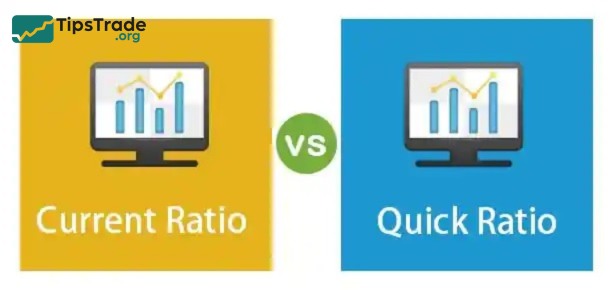The current ratio is an important financial metric in corporate financial analysis. Let’s explore what the current ratio is and how to calculate it in financial analysis with Tipstrade.org in the following article!
What is the current ratio?
The current ratio (or working capital ratio) is a type of liquidity ratio that measures a company’s short-term solvency. This index reflects whether a company has enough short-term assets to pay its short-term debts. Normally, with short-term debts, businesses will have a specified period of time to be able to pay. At that time, current assets are the main resource for businesses to pay short-term debts such as cash, inventory, receivables,…
Therefore, companies with a higher volume of current assets are generally better positioned to meet their short-term obligations, resulting in a higher working capital ratio.

Factors that can influence current ratio
Factors affecting the current ratio can be referred to as:
- Industry standard: The current ratio varies across industries. A ratio considered “good” in one industry might be considered “poor” in another. For example, manufacturing and capital-intensive industries often have lower working capital ratio compared to service companies.
- Seasonal fluctuations: The working capital ratio may fluctuate throughout the year. For example, businesses with seasonal sales cycles, such as retail stores, often have a higher working capital ratio during peak shopping seasons compared to other times of the year.
- Working capital management: The working capital ratio is influenced by how companies manage their capital. Companies that effectively manage working capital by balancing inventory, receivables, and payables may have a better working capital ratio than those that do not manage effectively.

How to calculate the current ratio
Current ratio formula
The current ratio formula is: Current Assets / Current Liabilities
Where:
- Current assets: These are highly liquid assets that can be converted into cash within one year. Items included in this category are cash and cash equivalents, accounts receivable, inventory, and prepaid expenses.
- Current liabilities: These are obligations that a company must settle within one year. This indicator includes short-term loans, accounts payable, taxes payable, and accrued expenses.

Example of the current ratio formula
For example, say your company’s balance sheet shows the following current assets and current liabilities as of Dec. 31, 2023:
Current assets:
- Cash: $150,000
- Accounts Receivable: $25,000
- Prepaid Expenses: $2,000
- Inventory: $75,000
- Total current assets: $252,000
Current liabilities:
- Accounts payable: $20,000
- Accrued expenses: $7,000
- Short-term debt: $15,000
- Total current liabilities: $42,000
With this information, we have the following formula:
Current ratio = $252,000 (current assets) / $42,000 (current liabilities)
So, your working capital ratio on Dec. 31, 2023 was: 6 => This means you could pay off your current liabilities with your current assets six times over.
What is a good current ratio?
A high or low working capital ratio will reflect whether a business has the ability to pay short-term debts or not.
- Current ratio > 1: Shows good short-term debt payment ability, the business has enough financial resources to operate and invest in the short term.
- Current ratio < 1: The business may have difficulty paying short-term debts when due.

Thus, the higher the working capital ratio, the more the enterprise proves its ability to pay short-term debts on time. However, if this ratio is too low, it does not mean that the enterprise will go bankrupt. At this time, the administrator will find ways to mobilize capital to cover the debt and maintain the operation of the enterprise.
In addition, the “ideal” current ratio also depends on the business industry, operating model and financial strategies of the enterprise. Therefore, there is no absolute number for the working capital ratio that the enterprise needs to achieve.
To evaluate the overall debt repayment capacity of a business, managers need to combine it with other financial ratios such as quick ratio, D/E ratio,…
Importance of current ratio to business
The calculation results of the working capital ratio holds significant value for a business, serving as one of the key metrics that allows managers to gain the most objective view of the company’s financial situation over different operational periods.
First, the working capital ratio result will show whether the company’s current short-term assets are enough to pay short-term debts or not? Then, from measuring the ability to pay short-term debts, managers can evaluate the efficiency of using the company’s assets to make decisions on raising capital in case the current short-term assets are not enough to pay debts.

Limitations of the current ratio
Of course, like any financial metric, the current ratio has its limitations that you must consider.
- Ignore timing of cash flows: A high current ratio may still coincide with liquidity issues if current assets cannot be quickly converted to cash to meet obligations.
- No insight into asset quality: The ratio does not assess how liquid or valuable the assets truly are. Some assets may be obsolete or difficult to convert into cash.
- Inventory may be misleading: A company with a large inventory might seem liquid, but if the inventory is slow-moving or obsolete, it won’t generate the needed cash flow.
- Accounts receivable risk: High receivables inflate the current ratio, but if customers delay or default on payments, the actual liquidity is much lower than the ratio suggests.
The relationship between current ratio and quick ratio
Relying solely on the working capital ratio to assess the short-term asset situation of a business may not be accurate enough. Therefore, the quick ratio was created to support the current ratio, providing more detailed information about the short-term debt payment ability of a business.

The quick ratio only includes cash, cash equivalents, and short-term receivables, which are assets that can be paid quickly and easily. Therefore, the quick ratio provides more accurate information than the working capital ratio about the company’s ability to pay short-term debts in an emergency.
In addition, the quick ratio assesses the ability of a business to pay short-term debts with its most liquid assets. When the quick ratio is many times smaller than the current ratio, this shows that short-term assets are still heavily dependent on inventories, leading to low liquidity of short-term assets.
Conclusion
The current ratio is an important financial metric that helps assess a company’s ability to meet its short-term liabilities. However, to gain a comprehensive view of the financial situation, it should be considered alongside other financial indicators. To learn more about other useful financial metrics, investors can regularly visit the Tipstrade.org website!

